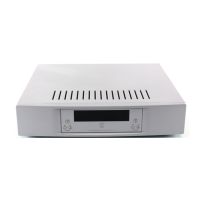Appendice B : Escape Sequences
Previous implementations of the RS232 protocol, excluded the use of specific characters within identifiers (#,
$, &, @ and spaces) and the command itself. These characters may now be included by using the escape
sequence \xHH, where HH is a two digit hexadecimal code representing the actual ASCII code of the
character.
This, for example, allows identifiers and command field data to contain spaces, which would otherwise be
treated as field separators.
For example, #Record Deck#
now becomes #Record\x20Deck#
and !$ARTIST name of artist$
becomes !$ARTIST name\x20of\x20artist$
The following (ASCII) characters must be encoded, if they are to be included as part of an identifier or as part
of a command.
- 32 (0x20) space - field separator
- 35 (0x23) # hash sign - source identifier delimiter
- 36 (0x24) $ dollar sign - command delimiter
- 38 (0x36) & ampersand - group identifier delimiter
- 64 (0x40) @ commercial at sign - destination identifier delimiter
- 92 (0x5C) \ backslash - escape sequence
- Additionally, top-bit set (ASCII codes 128-255) characters can now also be included, using the
same method.
Note:
1
Characters within the ranges 0 to 31, and 128 to 159 should not be used.
2
The main use of escape sequences will be to output Album, Artist and Track names. It is therefore
suggested that hosts do not use escape sequences unless absolutely necessary, thereby limiting any
possible problems when this product is connected to a daisy chain of products which includes previous
incarnations of Linn equipment (software in these products will simply treat them as raw ASCII data).

